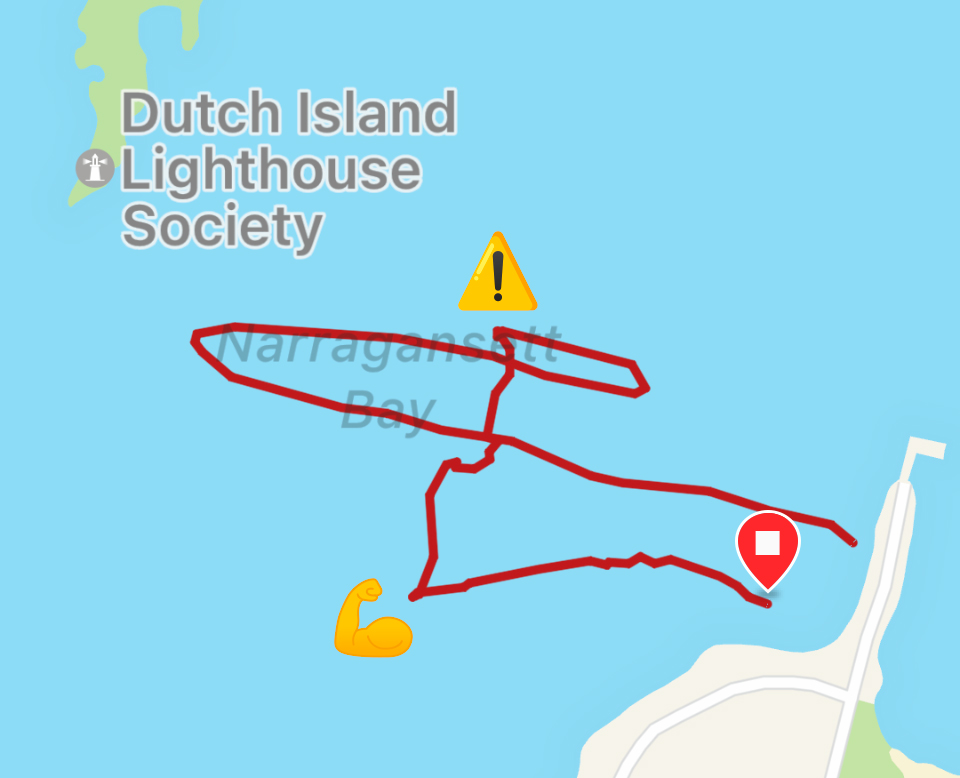As you know all too well by now, Paul and I have been wingfoiling a lot this summer. A few weeks ago we had our first breakdown/rescue, and I’d like to pass along a few key hindsight lessons.

Most of my wingfoiling has been inside what we call “the playpen,” a very sheltered area in the lee of a long beach. The water is flat, and though the prevailing breeze is offshore it would be easy to paddle/walk home if something broke or the wind completely died. But now that the water is summer-warm and I can reliably foil jibe, I’ve been venturing out to play in open water whenever time and tide allow.
This particular day was absolutely perfect, right up until it wasn’t: a steady seabreeze against outgoing ebb had kicked up some very playful junior varsity waves between the launching area and Dutch Island. I was into my second hour of fun, heading for the lighthouse and already thinking about the next wave-dancing jibe, singing to myself (ironically in hindsight), “Don’t worry, about a thing…” when I heard a very loud POP—and the wing exploded. What had been an air-filled “sail” was now useless flotsam.

I always wear a lifejacket (and helmet) and my foil board floats my weight, so after moving wrist leash to ankle I climbed back onboard and started paddling, wing dragging behind me. I’d done that plenty of times to get back to the playpen beach, but what I didn’t realize was that the ruptured wing was slowly filling up with water. What I DID realize was that despite my best paddling efforts, the board, foils, wing, and I were all slowly but steadily being swept out to sea by the ebb.
I tried swimming the board instead; similar speed. Holding range, maybe? Definitely not getting any closer to shore.
Paul was circling around, providing both moral support and a more visible reference for a couple of passing powerboats—none of whom realized there was anything wrong. He suggested I pull the wing up onto the board, and that was definitely better but also an obstacle to paddling (the center strut was still inflated). I dropped back into the water again, because all I could focus on was to “keep swimming.”
“You’re making progress,” Paul said, encouragingly. (The GPS track proves otherwise.) “Good thing you like to swim!”
After a few more minutes of effort, it was clear: I was not going to get back to shore under my own steam. So, after a short discussion, Paul came alongside close enough for me to grab his board leash. Instantly our speed doubled—even with me dragging in the water. (You can see where he picked me up from the second left turn on the GPS track.)

I should’ve climbed back onto the board, but again I didn’t want to pause our now visible progress. Especially once Paul somehow managed to pick up his wing and sail me and my gear back to the beach—where I nicknamed him my “rescue husband.”
Thanks to his strength and sailing abilities, the day ended well—though with far more swimming and paddling than expected. If you ever find yourself in a similar situation, here are the hindsight
Lessons Learned
1. Always deflate the wing and pull it up on the board. When I got it back to the beach I realized that its main tube had a big hole and had started to fill up with water, so it would’ve only gotten more waterlogged the longer it dragged behind me. Completely obvious, in hindsight!
2. Sail with a (strong, smart) buddy, or file a float plan.
3. Carry a communication device.
4. Consider the risks/rewards of your sailing location. Playing in the waves was really fun, but I was very glad the breakdown hadn’t occurred any farther from the beach.
5. Carry a whistle (it’s the law). If Paul hadn’t been there, that would’ve been my best way to ask one of the (otherwise oblivious) motorboats for help.
Despite the day’s dramatic finish, I’m very glad I went wingfoiling on such a perfect afternoon—and also very grateful for my rescue husband. Everything we do carries risk, but the next time there’s a wingfoiling breakdown I will definitely be a little smarter about how to get back to the beach—even if I’m the one doing the rescuing.
Hi Carol,
Good article and useful safety information for fellow wing sailors, but I think I’ll stay with a hull under me in my Force 5.
Have a remaining safe summer and hope to see you guys “winging it” in Key Largo this winter.
Tom Trump
UKSC
Tom, thanks for the comment and enjoy the Force 5 sailing! Hello to all the UKSC folks
Thanks for sharing your experience we all need these reminders to sharpen the safety plan. I’m shocked at how many people go out on the water (on anything) without a VHF. Another point I’d add is touch screen phones are really hard to use with soggy wet hands I don’t rely on them as my primary comms device.
Craig, great point about wet fingers and touch screens. Stay safe!
Would you consider flipping the board over then paddling it stern first ? Could secure collapsed wing around strut, less drag more visibility.
Michael, the downside of that would be NO lateral resistance so the board would be harder to paddle… and a big obstruction in the way as well! Thanks for the suggestion.